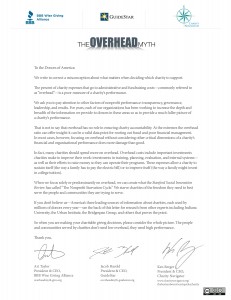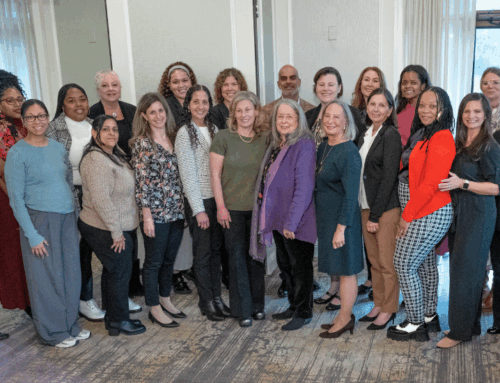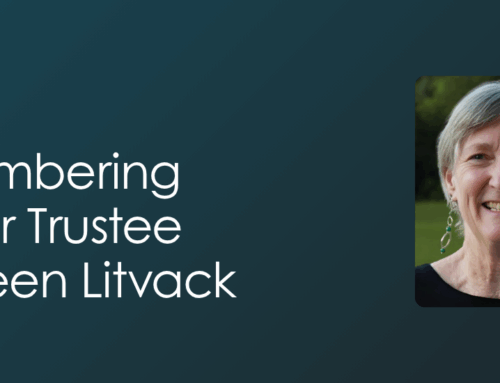– Nancy Kieling
President
 Just as I was drafting a piece on the topic of administrative and fundraising expenses and operating efficiencies, into my inbox popped The Overhead Myth, a new effort by three organizations that assess nonprofits, advocating that donors get off the “overhead is bad, efficiency is good” bandwagon. Amen.
Just as I was drafting a piece on the topic of administrative and fundraising expenses and operating efficiencies, into my inbox popped The Overhead Myth, a new effort by three organizations that assess nonprofits, advocating that donors get off the “overhead is bad, efficiency is good” bandwagon. Amen.
Even though the authors of the Overhead Myth are the same organizations that have given donors the financial data and in some cases suggested a few key ratios would reveal all, I’m still glad they have spoken up. You can read about the Overhead Myth here: http://overheadmyth.com . Click on the letter, and scroll to page 2. The research noted is important. Spend a few minutes reviewing it.
[push]When a nonprofit is too lean it can be inefficient[/push]As a nonprofit CEO and a grantmaker who has reviewed hundreds of nonprofits over the past 19 years, I suggest you also consider the following:
- The nonprofit sector shares an IRS code, but is not one business model any more than “for-profits” (like ShopRite and Apple) are alike. An affordable housing organization and a symphony have very little in common financially or programmatically. And yet I hear people talk about the sector as a monolithic ONE, assuming the business model is the same. Wrong.
- Since the business definition of overhead relates to those expenses that do not directly generate profits shouldn’t we think differently about these costs in organizations that are not run to make a profit, but rather to make life better, richer, more equitable? If the Y requires classroom space to teach ESL, is the rent overhead or a program expense? You can guess where my vote goes.
- Salary is a hot topic. Let’s consider what the staff of a nonprofit is doing, and how we should value it. In many cases people are dealing with critical issues in the lives of individuals and communities, working to solve some of society’s most difficult and intractable problems. Should that come cheap? Do we expect that addressing really hard problems can even be done by people with little experience or relevant skills? Are we ok with creating burn-out because the work is hard and the compensation is low?
- Nonprofit CEO’s, like their for-profit colleagues, run complex organizations, in some cases with tens or hundreds or thousands of staff. That takes skill and experience. Nonprofits employ 10% of the American workforce. A one-size-fits-all salary structure is silly, and a hard cap doesn’t reflect reality.
- When nonprofits tell me they work hard to keep their “overhead” below 10%, 15%, or some arbitrary number, I fear they are playing with the numbers. How would I know? Accounting practices are varied so analysis is an exercise in comparing apples and oranges. Forget that at your own peril.
- Donors tell me they only want to support “efficient” organizations, but when I ask what that is, they have no answer. They’ve heard this notion bandied about, but they can’t define it. Maybe that’s because it is hollow.
- The Overhead Myth has correctly identified the really important elements an effective organization needs to succeed:
- Leadership
- Transparency
- Governance
- Results (and I would add, accurately defined and reported)
Here at the Community Foundation we look carefully at many indicators that point to effectiveness. We know all too well how much energy is wasted when flexible and adequate financial support is missing. When a nonprofit is too lean it can be inefficient, spending a lot of energy filling in for absent infrastructure, making do with inadequate resources, unconnected to the networks needed to get the job done.
We encourage donors – individuals, foundations, corporations and government – to think carefully about this issue, and to do the work necessary to make an accurate and realistic assessment. It is hard work. Perhaps that’s why the notion that a simple ratio or percentage could hold the answer is appealing. There is no easy or magic bullet.
But you can ask your Community Foundation for help. We do this study every day, and we welcome the chance to help you do the same. We’re happy to share what we know. Call on us.





